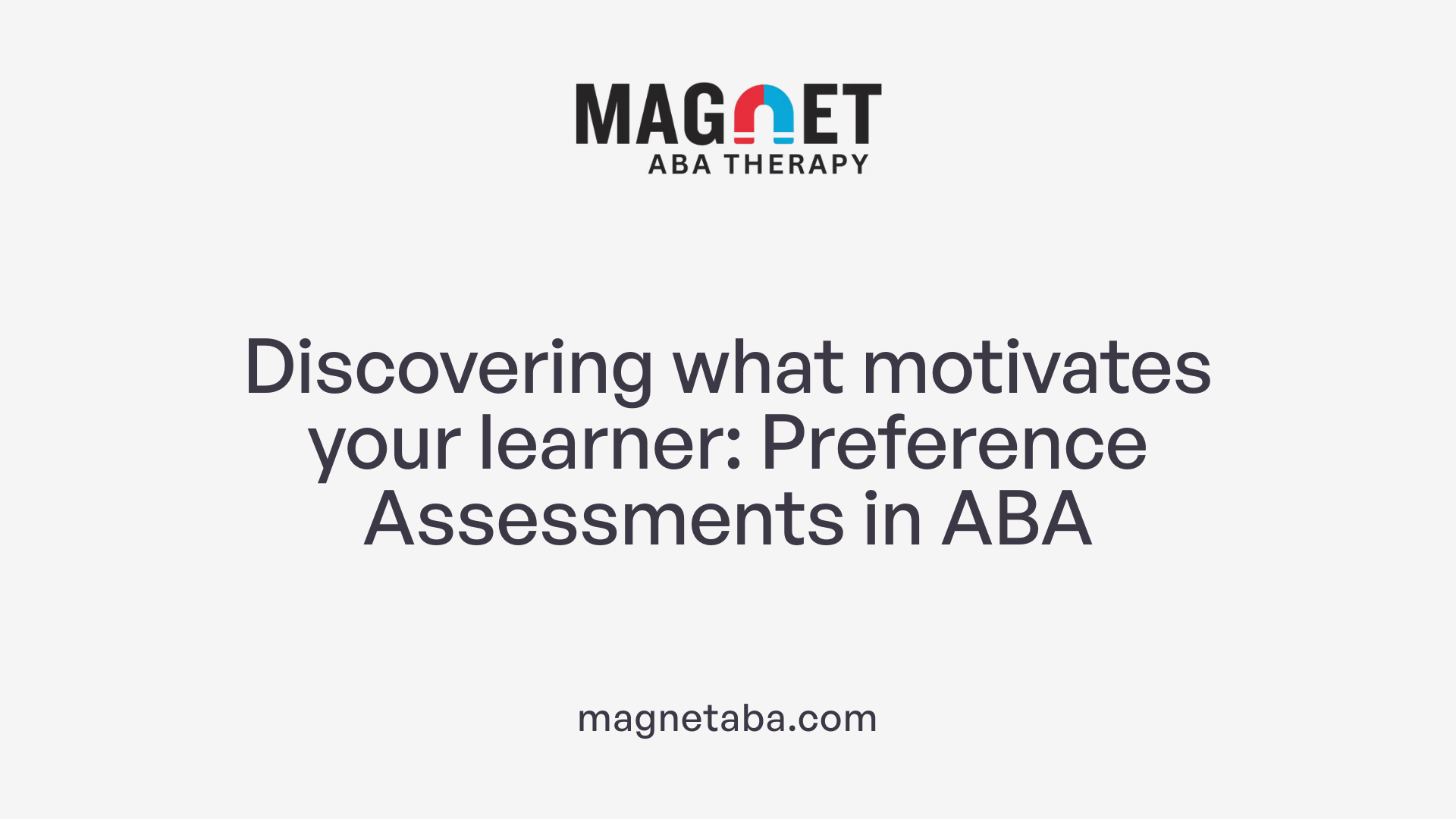Understanding the Role of Reinforcers in ABA Therapy
Applied Behavior Analysis (ABA) therapy is a cornerstone of behavioral intervention for individuals with autism. Central to its success is the strategic use of reinforcers — stimuli or items that increase the likelihood of desired behaviors. However, maintaining the effectiveness of reinforcers requires careful attention to factors like satiation and motivation. This article explores how to identify reinforcer satiation to preserve motivation and optimize therapy outcomes.
Foundations of ABA Therapy and Reinforcement Principles
What is Applied Behavior Analysis (ABA) therapy and how is it used to support individuals with autism?
Applied Behavior Analysis (ABA) therapy is a structured, evidence-based approach aimed at understanding and improving behavior in individuals with autism spectrum disorder. Rooted in B.F. Skinner’s operant conditioning theory, ABA helps teach new skills and reduce challenging behaviors by analyzing the antecedents, behaviors, and consequences (the A-B-Cs).
The therapy uses carefully designed reinforcement strategies to encourage positive behaviors such as communication and social interaction, while decreasing undesired actions. ABA programs are highly individualized, adapting to each learner's strengths and challenges and are implemented across different settings like home, schools, and community environments.
Role of reinforcement in ABA
Reinforcement is fundamental to ABA, serving as the primary tool for behavior change. By providing a stimulus following a behavior, reinforcement increases the likelihood that the behavior will occur again. The effectiveness of this process depends heavily on understanding and utilizing an individual's preferences and motivation.
Types of reinforcement
Reinforcement in ABA can be classified into:
- Positive reinforcement: Adding a pleasant stimulus to increase a behavior (e.g., giving a favorite toy after requesting it).
- Negative reinforcement: Removing an unpleasant stimulus to strengthen a behavior (e.g., turning off loud noise when the learner follows instructions).
- Contingent reinforcement: Delivering reinforcement only after a specific behavior occurs.
- Noncontingent reinforcement: Providing rewards regardless of particular behaviors, often used to reduce problematic behaviors but less precisely controlled.
- Immediate reinforcement: Given directly after the behavior, leading to better learning.
- Delayed reinforcement: Offered after a time delay, generally less effective.
Behavior change through reinforcement
ABA systematically applies reinforcement to promote desirable behaviors and reduce unwanted ones. Techniques like differential reinforcement provide greater rewards for preferred behaviors, helping learners acquire new skills and maintain them. For example, a teacher might provide praise or tokens for appropriate social interactions, while ignoring minor unwanted behaviors.
Overall, ABA therapy's reliance on reinforcement principles allows for clear, measurable behavior changes, enhancing independence and quality of life for individuals with autism.
Identifying and Managing Reinforcer Satiation
What is Reinforcer Satiation?
Reinforcer satiation occurs when a learner has had too much access to a preferred item or activity, causing it to lose its appeal and effectiveness as a reinforcer. In ABA therapy, this results in the child showing reduced motivation to engage in desired behaviors because the previously reinforcing stimulus no longer holds its value.
What Are Signs and Behavioral Indicators of Satiation?
Behaviorally, satiation can be observed when a child becomes indifferent or distracted by a reinforcer that once motivated them strongly. They may reject the item, show less enthusiasm, or decrease the frequency and intensity of the targeted behavior despite reinforcement attempts. These signs indicate that the reinforcement is losing its power and that motivation is waning.
How Does Satiation Impact Motivation and Behavior?
When satiation occurs, the effectiveness of reinforcement diminishes, leading to fewer correct responses and slower progress in therapy goals. The child may display frustration or avoidance behaviors, and this can negatively affect overall engagement and learning. Maintaining the reinforcer’s enticing nature is crucial for sustaining motivation.
What Strategies Can Help Avoid Satiation During Therapy?
To prevent satiation, therapists balance access to preferred items by regulating frequency and duration, ensuring the reinforcer remains desirable. Methods include:
- Using a variety of reinforcers to rotate and reduce overexposure.
- Implementing deprivation or withholding preferred items before sessions to increase motivation.
- Pairing less preferred stimuli with highly desired reinforcers (stimulus-stimulus pairing).
- Applying the Premack principle by reinforcing low-probability behaviors with access to high-probability activities.
- Monitoring behavioral cues closely and adjusting reinforcement schedules immediately.
By carefully managing reinforcer delivery and variety, ABA interventions maintain high motivation and promote effective learning outcomes.
Preference Assessments: Finding What Truly Motivates

What is the Purpose of Preference Assessments?
Preference assessments are essential tools in ABA therapy used to identify which stimuli may serve as effective reinforcers for learners, especially those with autism. These assessments help clarify what items or activities a learner currently finds motivating, allowing therapists to select reinforcers that increase desired behaviors.
What Are the Different Types of Preference Assessments?
There are several methods to evaluate preferences, including:
- Single Stimulus Assessments: Presenting one item at a time to observe the learner's reaction.
- Paired Choice Assessments: Offering two items simultaneously to let the learner choose.
- Free Operant Assessments: Observing natural interactions with available stimuli without restrictions.
- Social Preference Assessments: Evaluating a learner's preference for social interactions versus tangible items.
Each method has practical applications depending on the learner's abilities and the context.
How Do Preferences Change Over Time?
Preferences are fluid and influenced by motivating operations such as satiation (when a learner has had too much of an item) or deprivation (limited access), as well as factors like time of day and environment. This variability means ongoing preference assessments are necessary to maintain effective reinforcement strategies.
How Can Preference Assessments Help Prevent Satiation?
By regularly assessing preferences, therapists can monitor when a reinforcer’s appeal diminishes due to overexposure. This allows them to rotate or adjust reinforcers, balancing access to maintain motivation without causing satiation, ensuring consistent engagement and success in learning.
Reinforcer Assessments: Evaluating Effectiveness Over Time

What is the difference between preference and reinforcer assessments?
Preference assessments identify stimuli that a learner with autism might find motivating or enjoyable, serving as potential reinforcers. In contrast, reinforcer assessments measure how effective these stimuli actually are in increasing a targeted behavior. While preference assessments tell us what the learner likes, reinforcer assessments show us what actually works to encourage behavior change.
What methods are used for reinforcer assessments?
There are several methods to evaluate reinforcer effectiveness, including:
- Concurrent schedule assessments: Presenting two or more reinforcers simultaneously to see which one better increases the target behavior.
- Multiple schedule assessments: Alternating between different reinforcer schedules to determine their relative impact.
- Progressive schedule assessments: Increasing the effort required to obtain a reinforcer step by step until the learner stops responding, revealing the reinforcer's strength.
These methods help practitioners compare potential reinforcers in real time and assess their lasting impact on behavior.
How can reinforcement plans be adapted based on assessment outcomes?
Reinforcer assessments provide crucial data that inform adjustments in reinforcement strategies. If a reinforcer loses effectiveness, possibly due to satiation or changing motivating operations, it may be replaced or combined with other reinforcers. Regular assessments allow therapists to maintain reinforcement immediacy and contingency, ensuring that reinforcement remains meaningful and motivating.
What role do reinforcer assessments play in optimizing behavior intervention strategies?
By accurately measuring reinforcer effectiveness, these assessments help tailor interventions to each learner's changing preferences and motivational states. This optimization reduces maladaptive behaviors and enhances correct responding, making interventions more efficient and individualized. Reinforcer assessments ensure that ABA therapy continually aligns reinforcement with the learner's current needs, maximizing therapeutic progress.
Motivating Operations: The Key to Sustained Reinforcement Value

What are Motivating Operations (EO and AO)?
Motivating operations (MOs) are environmental variables that affect the value of a reinforcer and the likelihood of a behavior occurring. They include establishing operations (EOs), which increase the effectiveness of a stimulus as a reinforcer, and abolishing operations (AOs), which decrease this effectiveness.
How Do Satiation and Deprivation Influence Reinforcer Effectiveness?
Satiation happens when a learner has had too much access to a preferred reinforcer, causing its value to temporarily drop, thus reducing motivation. For example, a child who has had too many turns with a favorite toy might lose interest.
In contrast, deprivation involves limiting access to a preferred item or activity, increasing its reinforcing power and motivating the learner to perform the target behavior.
Balancing Access and Limitation to Maintain Motivation
Effective reinforcement plans carefully balance providing enough access to preferred items to keep them appealing but not so much that satiation occurs. This balance maintains the reinforcer’s appeal and supports sustained motivation.
Strategies to Increase Motivation Through Motivating Operations
One practical strategy involves withholding a preferred item until the learner makes an appropriate request, such as saying "buh" to request a ball. This approach leverages deprivation to enhance the item's value, encouraging functional communication.
By understanding and manipulating motivating operations, therapists and educators can optimize reinforcement effectiveness, leading to better learning outcomes in ABA therapy.
Professional Roles and Collaboration in ABA Therapy Delivery

Who typically provides ABA therapy and what qualifications do these professionals have?
ABA therapy is generally delivered by licensed professionals such as Board Certified Behavior Analysts (BCBAs) and Board Certified Assistant Behavior Analysts (BCaBAs). These experts possess specialized training in behavioral science, often holding advanced degrees in psychology, education, or applied behavior analysis. Certification via the Behavior Analyst Certification Board (BACB) is crucial, ensuring practitioners meet stringent standards through comprehensive exams and supervised clinical experiences.
In addition to BCBAs and BCaBAs, therapists and registered behavior technicians (RBTs) play pivotal roles. These professionals implement reinforcement strategies and individualized interventions designed by BCBAs, working closely with clients during therapy sessions.
Role of therapists and technicians in reinforcement implementation
Therapists and technicians are responsible for applying reinforcement methods consistently and accurately as part of the ABA program. Their duties include delivering preferred reinforcement promptly to motivate desired behaviors, carefully managing satiation and deprivation to maintain reinforcer effectiveness, and documenting progress. They also use prompting and reinforcement schedules under supervision to shape new skills while minimizing errors.
Importance of family involvement and teamwork in managing reinforcement
Family collaboration is vital in ABA therapy success. Caregivers often assist in identifying preferred reinforcers through preference assessments and help maintain reinforcement strategies across environments. This teamwork ensures reinforcement remains meaningful, supports generalization of skills, and balances reinforcement schedules to avoid satiation. By working closely with professionals, families contribute to creating consistent, motivating learning conditions that optimize behavioral outcomes.
Measuring ABA Therapy Effectiveness and Adjusting Reinforcement Strategies
How is the effectiveness of ABA therapy measured?
Effectiveness in ABA therapy is gauged through systematic data collection and analysis centered on specified behavioral and developmental goals. Therapists track observable changes such as improved communication, greater social engagement, and enhanced adaptive skills. Progress involves increased language use, initiating social interactions, and active participation in daily activities.
Quantitative data, including effect sizes from research, show meaningful improvements in intellectual functioning, language abilities, and social skills. These metrics help identify therapy benefits and guide the need for strategy adjustments.
Data collection and analysis in ABA progress monitoring
ABA therapists collect detailed records of behavior frequency, duration, and intensity during sessions. This data is charted over time to monitor trends and measure the impact of reinforcement approaches.
Regular analysis allows for early detection of plateaus or regressions. Adjustments to treatment plans, including reinforcer types, schedules, or intensity, are informed by these insights.
Indicators of successful reinforcement
Signs that reinforcement is effective include increases in the target behavior, consistency in responding, and reduced occurrence of maladaptive behaviors. Children show motivation to engage, often requesting reinforcers appropriately.
Maintaining immediacy and contingency in reinforcement delivery enhances outcomes, as does monitoring motivation levels to avoid satiation.
Adjusting reinforcers to prevent satiation and maintain effectiveness
Since reinforcement preferences change with conditions like satiation or deprivation, therapists balance exposure to preferred stimuli carefully. They may rotate reinforcers or use techniques like the Premack principle to sustain interest.
Preference assessments help update reinforcer selections, considering changes in motivating operations and the child's current desires.
Relationship between dosage and outcomes
Therapy intensity (dosage) correlates strongly with improvements; higher frequency and longer duration of sessions typically yield better outcomes in communication, social skills, and cognition.
Ongoing evaluation ensures the dosage fits the learner’s needs and progress, optimizing resource use and maximizing gains.
Expanding and Maintaining Reinforcer Effectiveness: Techniques and Best Practices

What strategies help expand and maintain the effectiveness of reinforcers in ABA therapy?
Several techniques ensure that reinforcers remain motivating and effective for learners with autism. The Premack principle, for example, uses a high-probability behavior (a preferred activity) to reinforce a low-probability behavior (a non-preferred task). This strategy cleverly encourages challenging behaviors by linking them with valued outcomes. Another effective approach is stimulus-stimulus pairing, where neutral stimuli are paired with established reinforcers to create new motivating factors, broadening the range of rewards.
Why is positive reinforcement preferred over punishment?
Positive reinforcement is emphasized in ABA due to its long-term benefits and lack of harmful side effects. It involves adding a pleasant stimulus following a desired behavior, increasing the likelihood that behavior will reoccur. This approach fosters a supportive learning environment and promotes cooperation, unlike punishment, which can create fear or avoidance. Framing instructions positively enhances the learner’s engagement and encourages repeated success.
How does incorporating choice and autonomy support sustained motivation?
Offering multiple opportunities for choice empowers learners and respects their preferences, fostering autonomy. Allowing selection among reinforcers or activities increases acceptance and willingness to participate. This approach not only sustains motivation but also improves cooperation and overall behavior during therapy sessions.
What roles do differential reinforcement and errorless teaching play?
Differential reinforcement methods focus on increasing desirable behaviors by reinforcing specific actions more heavily, while reducing unwanted behaviors. Techniques like DRA (Differential Reinforcement of Alternative behavior) or DRO (Differential Reinforcement of Other behavior) shape behavior effectively. Errorless teaching minimizes mistakes by providing prompts and reinforcing successes immediately, then gradually fading prompts to promote independence, maintaining the learner’s motivation and confidence.
How can reinforcer fatigue be avoided through planning?
Careful planning considers satiation and deprivation cycles to maintain reinforcer value. This balance involves providing enough access to preferred items to keep them appealing without causing overexposure, which can reduce motivation. Regular preference assessments help adjust reinforcement strategies dynamically, ensuring stimuli remain effective and engaging over time.
How do these practices relate to ABA therapy benefits for autism?
Applied Behavior Analysis (ABA) therapy significantly improves communication, social skills, and independence in individuals with autism by using these reinforcement strategies. By emphasizing positive reinforcement, incorporating choice, and employing systematic teaching methods, ABA fosters lasting behavior change and skill development in a supportive, individualized manner.
Maintaining Motivation Through Vigilant Reinforcer Management
Identifying reinforcer satiation is crucial for maintaining the effectiveness of ABA therapy interventions. By understanding the fluid nature of preferences, conducting ongoing preference and reinforcer assessments, and carefully managing motivating operations such as deprivation and satiation, therapists and caregivers can sustain motivation and optimize learning outcomes. Collaboration among qualified professionals and families ensures reinforcement strategies remain individualized and dynamic, supporting meaningful behavior change and improved quality of life for individuals with autism spectrum disorder.
References
- The Ultimate Guide to the Effective Use of Reinforcers ...
- Too Much of a Good Thing?
- Reinforcement: What it is & Why it's Important to ABA
- 10 ABA Tips and Techniques for ASD
- Who Qualifies for ABA Therapy: Eligibility Guide
- Applied Behavior Analysis (ABA)
- Qualifications of Behavior Service Providers
- The effectiveness of applied behavior analytic interventions ...
- How to Measure ABA Therapy's Effectiveness












